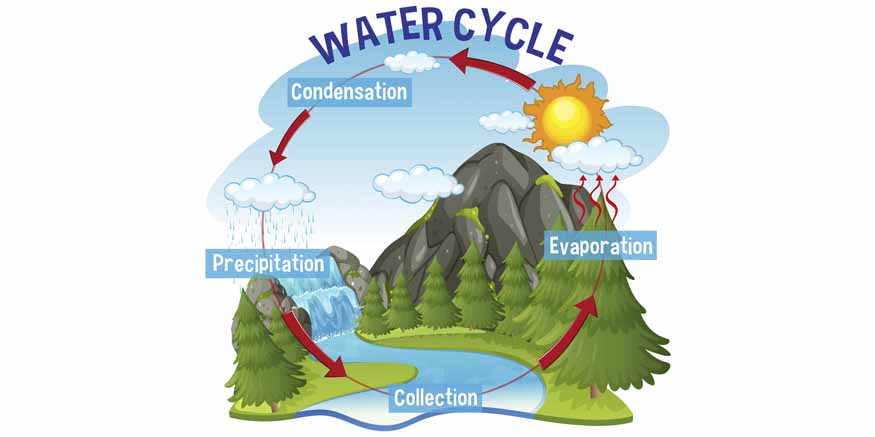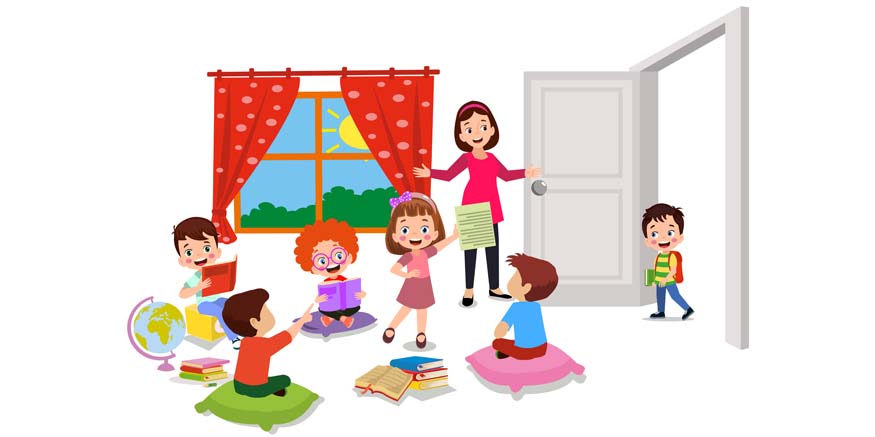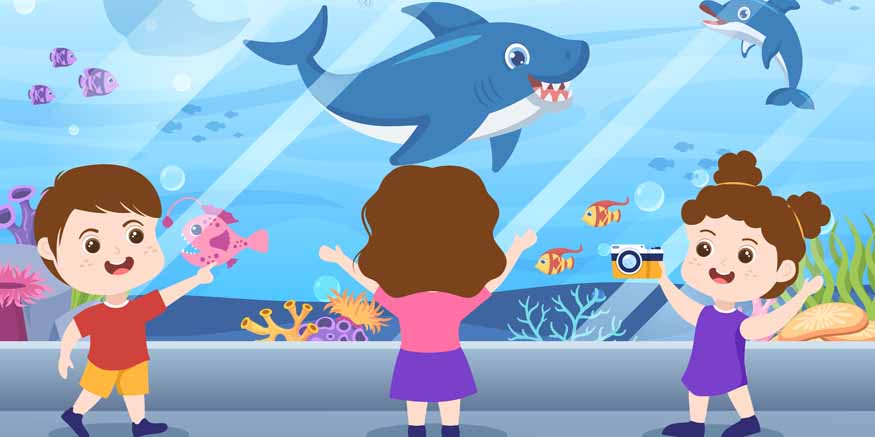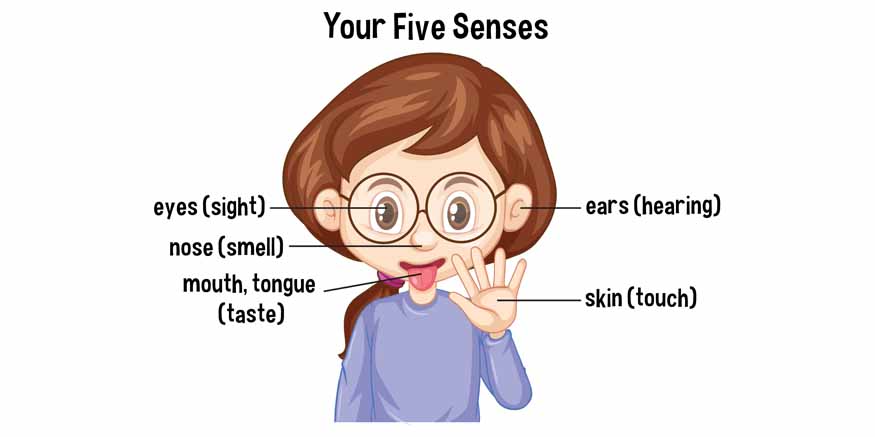Ever wonder where rain comes from or how puddles disappear? Let’s dive into the fascinating world of the water cycle and learn how water moves around our planet. The water cycle is a never-ending journey of water travelling from the ground to the sky and back again.
What is the Water Cycle?
The water cycle, also known as the hydrological cycle, is the continuous water movement on, above, and below the Earth’s surface. It involves various processes that keep water circulating on our planet, ensuring that we always have water in different forms. The water cycle is essential for all living things, including plants, animals, and humans. Now, let us explain the water cycle step by step.
Water Cycle Steps
The water cycle process involves several key steps that work together to move water around the Earth. Here are the main steps of the water cycle:
- Evaporation
- Condensation
- Precipitation
- Collection
- Evaporation
- Condensation
- Precipitation
- Collection
Evaporation is the process where water changes from a liquid to a gas, called water vapour. This happens when the sun heats up the water in rivers, lakes, and oceans, causing it to rise into the air as water vapour. Think of it like boiling water on the stove—the steam you see is water vapour!
Fun Fact: Did you know that about 90% of the water vapour in the atmosphere comes from the oceans? That is because they cover more than 70% of the Earth’s surface!
When water vapour goes up into the atmosphere, it cools off and turns back into small water droplets in a process known as condensation. These little droplets then gather together to create clouds. Have you ever noticed how a cold drink gets wet on the outside? That is condensation in action!
Interesting Fact: Clouds are made up of millions of tiny water droplets or ice crystals. They can look fluffy and white like cotton candy or dark and grey like a stormy sky.
When the clouds become too heavy with water droplets, they release the water as precipitation. Precipitation can come in different forms, including rain, snow, sleet, and hail. Rain is the most common form of precipitation, and it is what fills up rivers, lakes, and ponds.
Fun Fact: The largest raindrops ever recorded were about the size of a quarter!
When rain or snow falls to the earth, it gathers in different areas like rivers, lakes, oceans, and even beneath the surface. This water reenters the water cycle, waiting to be heated by the sun and begin the process again. Additionally, some of the water soaks into the soil and turns into groundwater, which is essential for plants and animals.
Interesting Fact: Only about 3% of the Earth’s water is fresh water that we can drink. The rest is salty ocean water!
The Importance of the Water Cycle
The water cycle is incredibly important for many reasons. Here are some of the key reasons why the water cycle is essential:
- Provides Fresh Water: The water cycle ensures a continuous supply of fresh water for drinking, cooking, cleaning, and growing plants.
- Supports Life: All living things need water to survive. The water cycle provides the water needed for plants, animals, and humans to live and thrive.
- Regulates Climate: The water cycle helps regulate the Earth’s climate by distributing heat and moisture around the globe.
- Replenishes Water Sources: The water cycle replenishes rivers, lakes, and underground water sources, ensuring that we have enough water for various activities.
The Water Cycle Steps and Their Processes
Step | Process | Description |
Evaporation | Liquid to Gas (Water vapour) | Water from oceans, rivers, and lakes evaporates into the air due to the sun’s heat. |
Condensation | Gas (Water vapour) to Liquid (Water Droplets) | Water vapour cools down and forms tiny droplets, creating clouds. |
Precipitation | Water Droplets Fall as Rain, Snow, Sleet, or Hail | Clouds release water droplets as precipitation, which fall to the ground. |
Collection | Water Gathers in Rivers, Lakes, Oceans, and the Ground | Water collects in various places, ready to start the cycle again. |
Fun Facts About the Water Cycle
Fact 1: Every drop of water you drink has been through the water cycle many times. Imagine drinking the same water that dinosaurs drank millions of years ago!
Fact 2: The water cycle is powered by the sun. Without the sun’s energy, there would be no evaporation, and the water cycle would not work.
Fact 3: Some clouds can hold millions of tons of water. That is like carrying the weight of a massive ship in the sky!
Activities to Learn About the Water Cycle
Here are some fun activities to help you learn more about the water cycle:
- Water Cycle in a Bag
- Plastic zipper bag
- Water
- Blue food colouring (optional)
- Tape
- Window with sunlight
- Fill the plastic bag with a small amount of water and add a few drops of blue food colouring if desired.
- Seal the bag tightly and tape it to a sunny window.
- Watch as the water evaporates, condenses on the bag’s surface, and forms droplets, mimicking the water cycle.
- Cloud in a Jar
- Jar with lid
- Hot water
- Ice cubes
- Hairspray
- Fill the jar with a small amount of hot water.
- Spray a small amount of hairspray into the jar and quickly place the lid on.
- Place ice cubes on top of the lid.
- Watch as a cloud forms inside the jar due to condensation.
Create a mini water cycle in a plastic bag!
Materials Needed:
Steps:
Make your cloud in a jar!
Materials Needed:
Steps:
Conclusion
The water cycle is a magical and essential process that keeps our planet’s water moving and provides us with the fresh water we need to survive. From evaporation and condensation to precipitation and collection, each step of the water cycle plays a vital role in maintaining the balance of water on Earth. By understanding and appreciating the water cycle, we can better appreciate the importance of water in our lives.
So, next time you see a cloud in the sky or feel the rain on your face, remember the incredible journey that water takes through the water cycle.
For more such informative/interesting blogs, visit Mother’s Pet Kindergarten.













Recent Comments